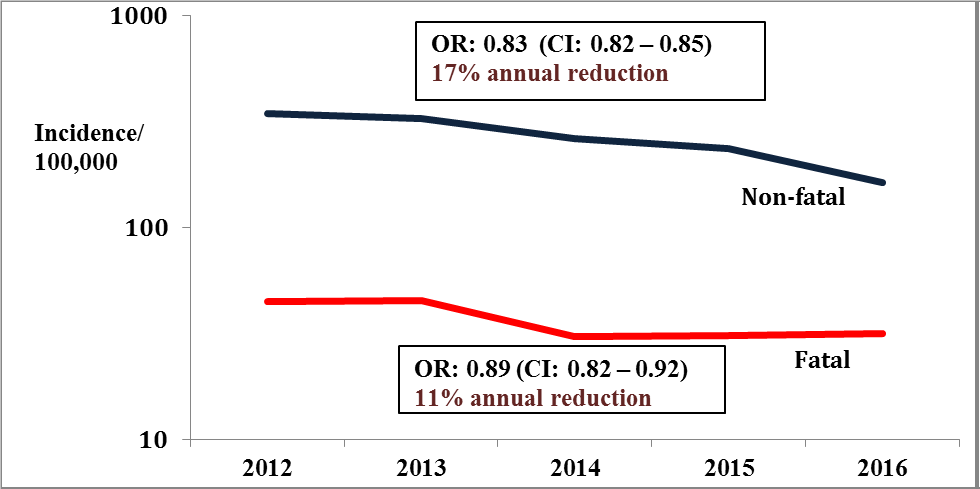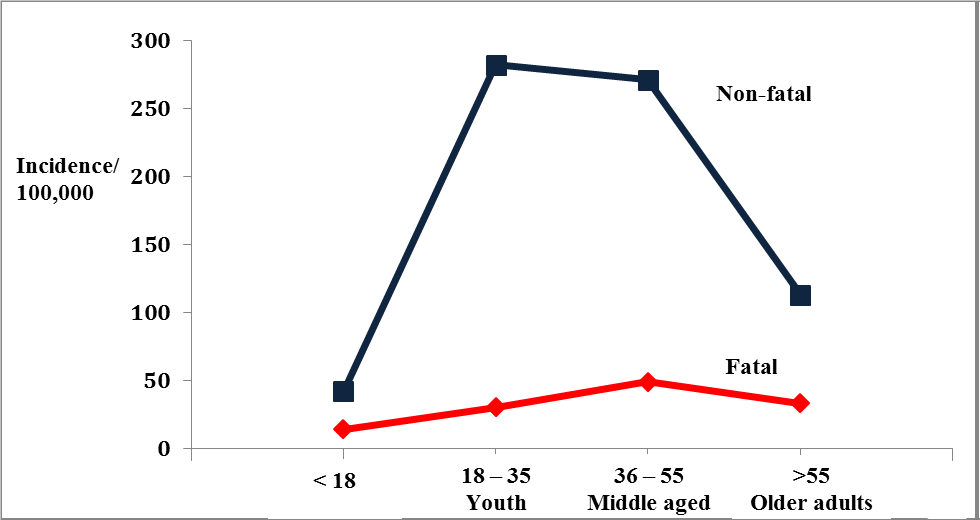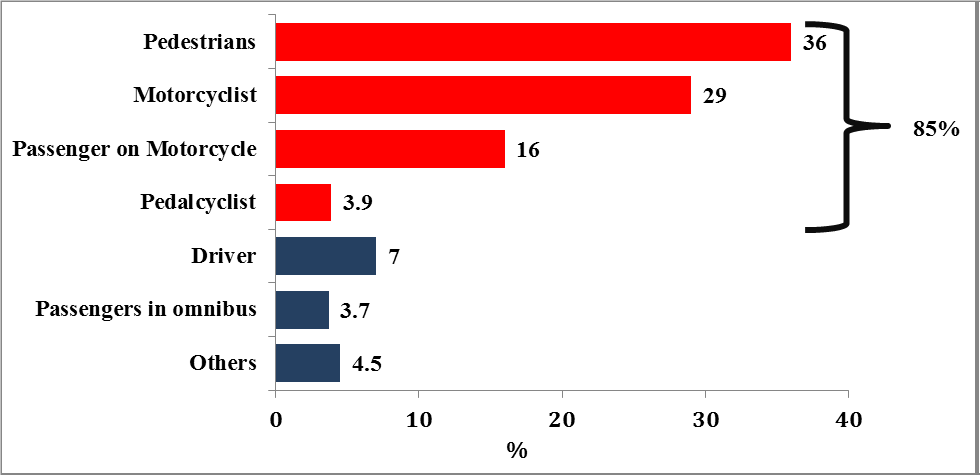Incidence of Road Traffic Injuries in Kampala, Uganda, 2012–2016
Authors: Claire Biribawa1*, Phoebe Hilda Alitubeera1, Alex Riolexus Ario1, Merissa Yell-man2, Olive Kobusingye3
Affiliations: 1Uganda Public Health Fellowship Program, Kampala, Uganda, 2Synergy America, Inc., Atlanta, Georgia, USA, 3Makerere University School of Public Health, Department of Environmental Science and Disease Control, Kampala, Uganda
Summary
Annually, road traffic injuries (RTIs) kill 1.3 million people and cause 20-50 million serious injuries globally. Uganda’s estimated rate of RTIs is high, and 50% of these RTIs occur in Kampala. Understanding the burden of RTIs, especially in the country’s cap-ital, is crucial for effective allocation of resources and for setting up targeted effective interventions. We described the burden of RTIs in Kampala by determining the fatal and non-fatal rates of RTIs, prevalence of RTI risk factors, and RTI trends from 2012-2016. We conducted a retrospective descriptive analysis using Uganda Traffic Police Department surveillance data. We calculated annualized RTI death and injury rates per 100,000 population and compared them between different population segments and time periods. In 2016, RTCs resulted in 493 deaths and 2,528 injuries in Kampala. Pedestrians were the most commonly affected road users for both fatal (50%) and non-fatal RTIs (36%). The rate of fatal RTIs declined from 44.6 in 2012 to 31.7 in 2016 per 100,000 population. From 2012-2016, the fatal RTI rate decreased by 29% in Kampala. However, the fatal RTI rate in Kampala (31.7%) is still almost twice as high as the global rate (17.4). There is a need to establish interventions to curb RTIs. RTI prevention strategies in Kampala should emphasize vulnerable road users (pedestrians/motorcyclists) and young adult males, who bore the highest proportional burden of RTIs.
Introduction
The WHO Global Road Safety Report released in December, 2018 reported that deaths from road traffic crashes had in-creased to 1.35 million a year approximating to about 3,700 people dying on the world’s roads every day(1). However, mortality alone does not represent a complete picture of the impact of RTIs since it is estimated that between 20 – 50 million people suffer from non-fatal RTIs leading to prolonged hospitalizations and disability contributing to the overall burden at both the household and national level (2,3).
Vulnerable Road Users (VRUs) disproportionately share this burden of RTDs and injuries (1). VRUs are those ex-posed to greater danger in the event of a crash because of poor protection from impact forces (e.g. pedestrians and 2 & 3 wheeled riders) and those who are less resilient in the event of trauma.
Kampala City is faced with a high and increasing proportion of VRUs, making VRU traffic injuries a major public health challenge for the city. According to KCCA report, commercial motorcyclists – Bodaboda account for 40% of the motorized transport in Kampala(4).
According to the 2017 annual crime report, RTCs in Uganda registered an 8.6% reduction from 14,474 in 2016 to 13,244 in 2017. Pedestrians accounted for 38% of all road traffic deaths in Uganda in 2017 followed by motor-cyclists who contributed 26% of all the RTDs. The report also indicated that 41% of the Road Traffic Crashes in Uganda occurred in Kampala Metropolitan Area. The proportion of VRUs that account for the burden of RTIs in Kampala is however unknown. We assessed the trend of RTIs from 2012 to 2016 in Kampala and describe the burden of RTIs among VRUs to inform control interventions.
Methods
We conducted a retrospective descriptive cross-sectional analysis investigating fatal and non-fatal road traffic injuries utilizing routinely collected data from Uganda Police Force. We obtained traffic crash records pertaining all individuals that sustained road traffic injuries within Kampala District during the period of 2012- 2016.
The data from Police records that were used for this study are collected and maintained by Uganda Police Traffic Department. Traffic officers who report at a traffic crash scene complete a form on cause of the road traffic crash, characteristics of victims involved, injury severity, vehicles involved and injury severity. Permission from the Inspector General of Police department and the Re-search department was obtained in order to get access and utilize data from the traffic department.
We calculated annual fatal and non-fatal road traffic in-jury rates using the Uganda Population Estimates of 2014. We used logistic regression to assess the trends. We also described the risk factors for road traffic injuries.
Results
In 2012, the fatal incidence rate was 45/100,000 populations and the incidence reduced to 32/100,000 in 2016. The incidence for non-fatal RTIs in 2016 almost halved from 344/100,000 populations in 2012 to 164 per 100,000 population in 2016 (Table 1).
| Year | Population | Fatal RTI | Incidence rate per 100,000 | Nonfatal RTI | Incidence rate per 100,000 |
| 2012 | 1,449,556 | 647 | 44.6 | 4996 | 345 |
| 2013 | 670 | 45.3 | 4855 | 328 | |
| 2014 | 1,507,080 | 463 | 30.7 | 3956 | 262 |
| 2015 | 1,528,800 | 472 | 30.9 | 3597 | 235 |
| 2016 | 1,555,600 | 493 | 31.7 | 2528 | 163 |
The incidence of both fatal and non-fatal injuries reduced over time. The odds ratio which is 0.83 represents a 17% annu-al reduction. The odds ratio for fatal injuries which is 0.89 represents an 11% annual reduction (Figure 1).

Male preponderance was observed for fatal RTIs in 2016 .The male to female ratio of 8.1:1 for fatal RTIs and 3.1:1 for non-fatal RTIs. The gap between the genders widened as the age progressed and peaked at the 35–44 age-group. The gap then reduced with increasing age as seen from the ratios (Table 2).
Table 2: Fatal RTIs Kampala, 2016, Male to Female Ratio
| Age group | Males | Females | Ratios |
| Below 18 | 55 | 30 | 1.8 : 1 |
| 18 – 24 | 15 | 13 | 1.2 : 1 |
| 25 -34 | 138 | 30 | 4.6 : 1 |
| 35 -44 | 66 | 8 | 8.3 : 1 |
| 45 – 54 | 23 | 7 | 3.3 : 1 |
| 55 – 64 | 10 | 2 | 5 : 1 |
| 65 – 74 | 3 | 3 | 1 : 1 |
| 75 & above | 0 | 1 | 0 |
The youth aged 18 – 35 years and the middle aged 35 – 55 years had the highest incidence of RTIs in 2016 (Figure 2).

Vulnerable Road Users account for 85% of the fatal RTIs in Kampala. Pedestrians were the most affected road user category contributing 36% of the fatal RTIs. These were followed by motorcyclists who contributed 29% of the fatal RTIs (Figure 3).

Discussion
The incidence of fatal and non-fatal RTIs had declined over the period of 2012 – 2016. The decline can be attributed to investments that have been put in place to address road safety in Uganda. Interventions which have been put in place by Uganda Police Force include: express penalty scheme for reckless driving, regular inspection of vehicles for assessment of vehicle safety, testing drivers per class of driving permit, regular check-points to monitor speed limits, regular operations targeting motorcyclists who violate traffic laws, routine training of traffic officers for capacity building, strict enforcement of traffic laws and sensitizing the public on road safety(5).
Despite the decline seen over the 5 year period, the fatal RTI rate in 2016 was 31.7 per 100,000 which is still almost twice as high as the global rate of 17.4 per 100,000 (2). The high burden of RTIs in Kampala District can be attributed to an increase in automobiles and motorization, the traffic mix, overcrowding due to rapid population growth, and heavy commercialization (6,7). This then calls for more investments in road safety to be done by all key actors through a multi-sectorial approach looking at policy and other targeted interventions.
Globally, only half of the Road Traffic Deaths are among VRUs.
However in Kampala, VRUs accounted for 85% of the fatal RTIs. The study indicated that pedestrians and motorcyclists who are vulnerable road users contributed more than half to the burden of RTIS followed by passengers on motorcycles. This calls for a need to re-strategize our road safety options and put in to consideration VRUs. Most of the roads in place are designed with no pedestrian road safety features in place. Pedestrians compete for space with motorized vehicles. If pedestrian walkways are in place, bodaboda still encroach on them. Pedestrian crossing facilities are also absent in some key pedestrian attracting areas. In addition, enforcement of safety options such as helmets in case a traffic crash occurred are barely present. Uganda has a law for helmet use but enforcement is still lacking, and this goes for passengers on motorcycles. Reflector jackets for better acuity in the night are absent.
Conclusions and Recommendations
The Incidence of fatal RTI rates have decreased over the 5-year period although the fatal RTI rate in Kampala District is still almost twice as high as the global rate of 17.4 per 100,000. In addition vulnerable road users and young adult males were the most affected category. There is thus a need to establish interventions to curb RTIs. RTI prevention strategies in Kampala District should emphasize vulnerable road users (pedestrians/motorcyclists) and young adult males, who bore the highest proportional burden of RTIs. There is need to institute pedestrian safety features such as pedestrian walkways, and pedestrian crossing facilities, among others.
References
WHO. Global status report on road safety 2015. World Health Organization; 2015.
Mock, Jurkovich GJ, Arreola-Risa C, Maier RV. Trauma mortality patterns in three nations at different economic levels: implications for global trauma system development. J Trauma Acute Care Surg. 1998;44(5):804–814.
Kopits E, Cropper M. Traffic Fatalities and Economic Growth–World Bank Policy Research Working Paper 3035. Wash DC USA World Bank. 2003;
WHO. Global status report on road safety 2013: supporting a decade of action. World Health Organization Geneva; 2013.


Comments are closed.